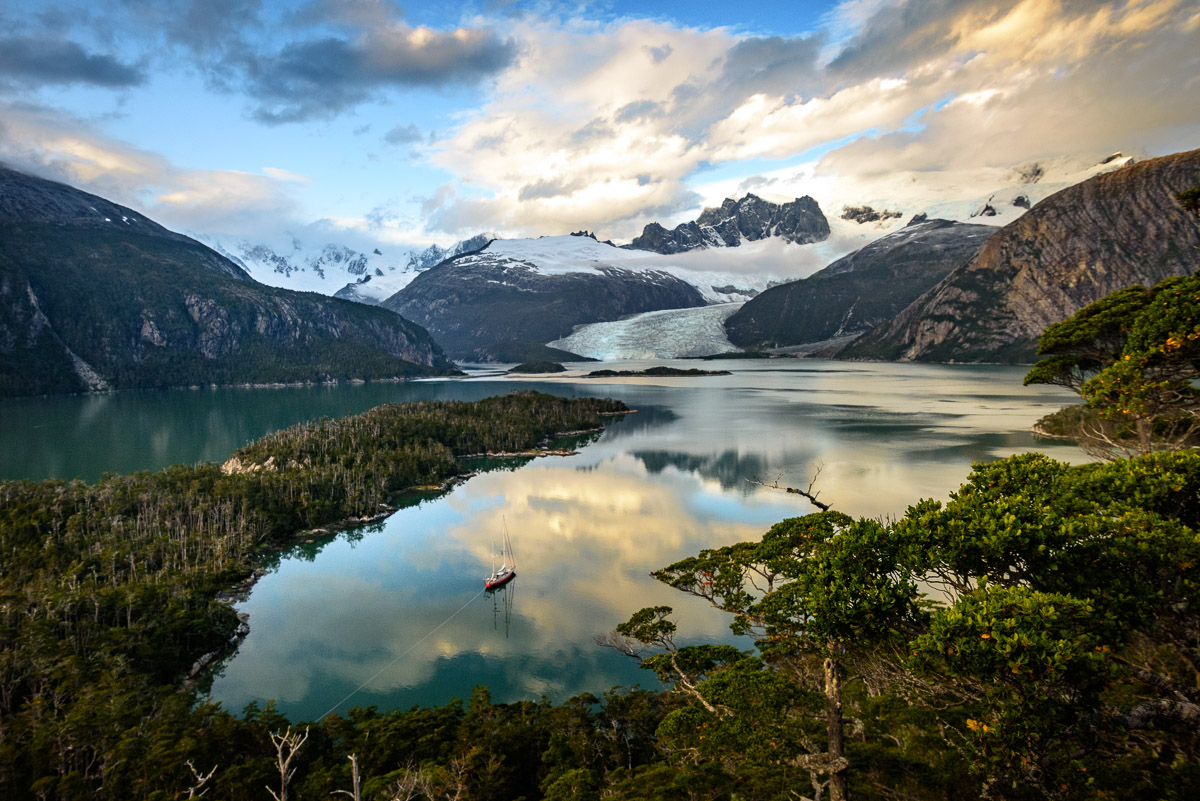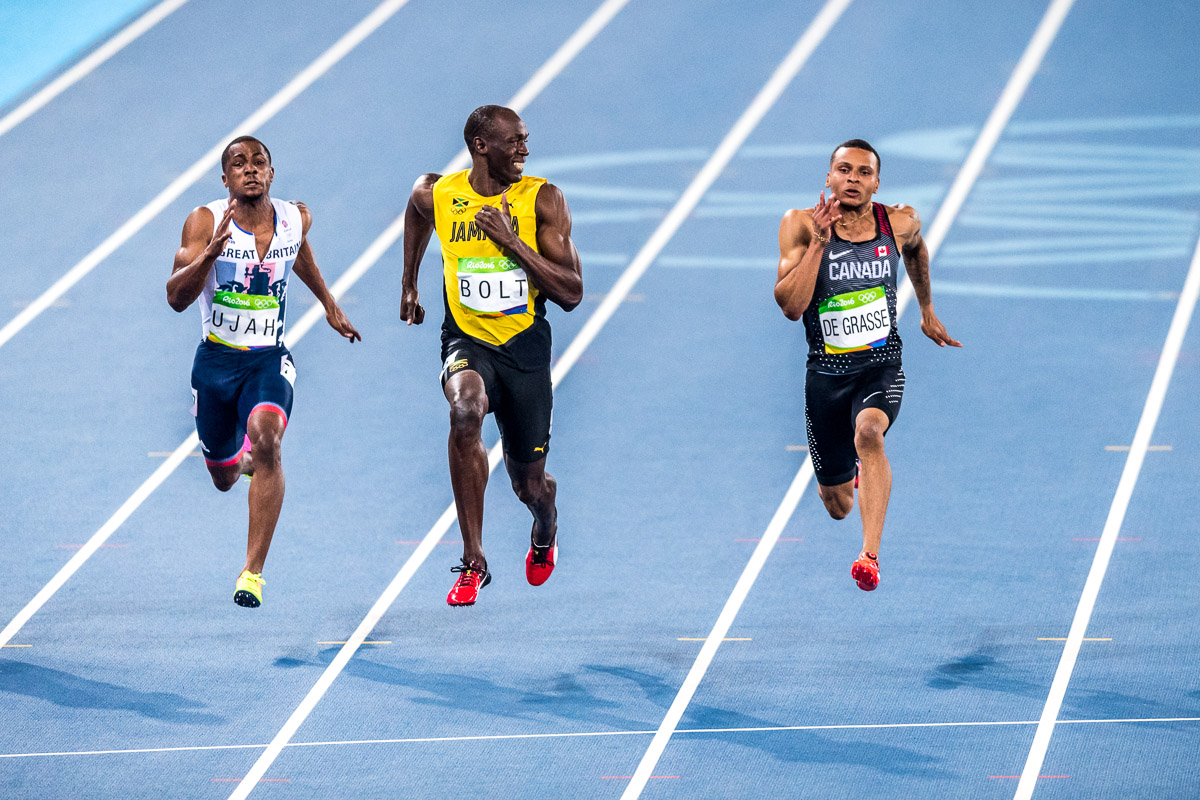What Is A Camera Body
We'll start this class with a rather gentle introduction, by request ourselves what a photographic camera actually is, and what its different components are. Chances are that yous will already know some of this, but going through it anyway volition at least ensure that we take defined a common vocabulary.

In the strictest sense, information technology is simply a device which can record calorie-free. It does so by focusing light on a photosensitive surface. From this elementary judgement, we can see the three main parts of whatsoever photographic camera.
The photosensitive surface reacts to light through either a chemic process (film) or an electric one (digital sensor). At that place are fundamental differences between these 2, which we will cover in a subsequent lesson, only for at present we can consider both of them to be identical: they are a grid of several million tiny dots (pixels) and each can retrieve how much light information technology received in a given menses of time. There are three important qualities to each sensor: resolution, size and what we can call "quality".
- Resolution is simply the number of pixels (it is slightly more than complicated with film, permit's forget about it for at present). The more pixels y'all have, the more than fine grained details you can theoretically record. Any resolution above 2 or 3 megapixels (i.e. millions of pixels) will be enough for displaying on a screen, merely higher resolutions come up into play for two important applications: printing and cropping.
- In club to have a good reproduction quality, it is generally estimated that between 240 and 300 pixels should be used for every inch of paper (dots per inch, or dpi), which volition requite a natural limitation to the biggest size one can print. For instance, a 6MP image of dimensions 2000×3000 pixels can be printed at a maximum size of 12.five×8.3″ at 240dpi (2000/240 = eight.3, 3000/240 = 12.5). It is possible to print bigger by either lowering the dpi or artificially increasing the resolution, but this will come at a serious loss of image quality. Having a higher resolution allows you to print bigger.
- Cropping means reducing the size of an image by discarding pixels on the sides. Information technology is a very useful tool and can frequently improve limerick or remove unwanted elements from an image. Nonetheless, it volition also subtract resolution (since you lose pixels), and so how much cropping you let yourself will depend on the initial resolution, which y'all want to be as high as possible. This is also what some cheaper cameras phone call "digital zoom", which use should exist avoided equally the plague, every bit the same outcome tin very easily be reproduced in postal service-processing, and the loss of image quality is often enormous.
- The concrete size of the sensor is very of import and will have an affect on many other parameters, most of which we will see in subsequent lessons: crop factor, depth of field, high ISO noise, dynamic range are some of them. Bigger sensors will also let to have more than widely spaced pixels (increasing image quality) or more of them (increasing resolution). Bigger is almost ever better, and this is i of the main reasons that DSLRs (and medium format cameras) produce much better images than compact cameras. In tomorrow's lesson, we will cover the different types of cameras in more details.
- Finally, sensor quality is harder to quantify, but information technology refers to how well the sensor reacts to hard lite conditions: either depression light which will require to increase ISO and for which we desire the sensor to accept as little noise as possible, or high dissimilarity, which will require a good dynamic range to be recorded fairly.

The lens is the second component of whatsoever camera. It is an optical device which takes scattered light rays and focuses them neatly on the sensor. Lenses are oftentimes complex, with upwardly to 15 unlike optical elements serving different roles. The quality of the glass and the precision of the lens will be extremely important in determining how skilful the final image is.
Lenses must brand compromises, and a perfect all effectually lens is physically incommunicable to build. For this reason, good lenses tend to be specialized and having the ability to switch them on your camera will prove extremely useful.
Lenses usually come with cryptic sequences of symbols and numbers which describe their specifications. Without going too much into details, let's review some of their feature:
- Focal length refers roughly to the "zoom level", or angle of view, of the lens. It will have its own lesson in a few days, as it can exist a surprisingly tricky bailiwick. A focal length is ordinarily expressed in millimeters, and y'all should be aware that the resulting angle of view really depends on the size of the sensor of the camera on which the lens is used (this is chosen the crop factor). For this reason, we frequently give "35mm equivalent" focal lengths, which is the focal length that would offer the same view on a 35mm camera (the celebrated film SLR format) and allows united states of america to make meaningful comparisons. If in that location is a single length (east.g. 24mm), then the lens doesn't zoom, and it is often chosen a prime lens. If at that place are two numbers (east.one thousand. 18-55mm), then you lot tin apply the lens at any focal in that range. Compact cameras often don't give focal lengths but simply the range, for example 8x. This means that the long end is 8 times longer than the wide one, so the lens could for instance be a 18-144mm, or a 35-280mm, etc.
- The aperture is a very important concept which nosotros will talk near in much particular subsequently on. The aperture is an iris in the centre of the lens which can shut to increasingly small sizes, limiting the corporeality of lite which gets on the sensor. It is refered to as a f-number, for case f/2.viii. To make things worse, it is quite counter-intuitive, as the smaller the number, the bigger the discontinuity! For now, we don't have to worry almost this too much. The important number on a lens is the maximal aperture, the lower the better. Professional zoom lenses oft accept f/2.eight maximal apertures, and cheaper consumer lenses have ranges such as f/three.five-5.6, meaning that at the wide terminate, the maximum aperture is f/iii.5 and at the long end, it is f/v.vi. Aperture tin be closed to tiny levels, usually at to the lowest degree f/22.
- Lenses also need a focusing organization. Nowadays, most lenses take an internal motor which can be piloted by the camera: the autofocus. They too have a ring to allow the photographer to focus manually. There are plenty of options for autofocus motors as well, for instance hypersonic or silent ones.
- Lenses are increasingly equiped with stabilisation systems (called VR past Nikon, IS by Canon). They detect small movements, ordinarily handshake, and compensate for them by moving internally the optical elements in the opposite management. Though no magic pills, those systems tend to work very well and allow to take sharp images at quite ho-hum shutter speeds.
- Finally, lenses can accept all sorts of fancy options: apochromatic glass, nano-coating, etc, designed to increment the quality of the final image. You lot probably shouldn't worry too much about those.

Finally, the body is the lite tight box connecting the lens to the sensor, and ordering anybody around. Though some film cameras are merely that, black boxes, most digital cameras are now small computers, sporting all sorts of features, often of dubious usefulness. Let'southward review some of the components institute in most bodies:
- The most of import is probably the shutter. Call up of information technology every bit a curtain in front of the sensor. When yous press the trigger, the curtain opens, exposes the sensor to lite from the lens, so closes once more after a very precise amount of time, oftentimes a tiny fraction of a 2nd. Most shutters operate between 30 seconds and 1/4000s of a second. That elapsing (the shutter speed) is 1 of the three very of import exposure factors, along with discontinuity and ISO.
- A calorie-free meter. As the proper noun suggests, it measures the quantity of light and sets the exposure accordingly. How much manual command you keep at this stage is i of the most important questions in photography. In that location are different metering modes, but except in very specific cases, using the about avant-garde, virtually automated ane (matrix metering on Nikon cameras) will provide the best results.
- A focus detector, used to bulldoze the autofocus motor in the lens. There are ii competing technologies, dissimilarity detection and phase detection, with at the moment an edge for the latter, which explains why DSLRs tend to focus faster than meaty cameras. These systems tend to vary greatly between basic and advanced bodies, but it should be noted that they all demand reasonable amounts of light to work properly.
- A way to store the image just created. Back in the days of picture, this was just a lever to advance the roll to the side by side unexposed frame. Now, information technology is a pipeline which ends up in the memory card that the camera is using. If you are shooting jpg instead of raw (more than on this in another lesson), there is an additional stage where the internal reckoner performs all sort of black magic on the image to output a set up-to-view jpg file.
- A way to frame. It tin be a multitude of things, optical or electronic viewfinder, LCD screen or even ground glass. Here too, DSLRs have an edge as an optical viewfinder allows "through-the-lens" viewing and immediate feedback, while electronic viewfinders (actually, a LCD screen inside a viewfinder) and LCDs frequently have limited resolution and slight updating delays.

Assignment
Accept a good look at your camera, whatever its blazon, and endeavor to identify each component we have discussed here. Information technology might exist a proficient opportunity to dig out the manual or to look upwardly its verbal specifications online. Now look up a dissimilar camera online (for instance at dpreview) and compare their specifications. Try doing this for both a less advanced and a more advanced body, and for different lenses. Report here if you find any interesting divergence, or if some parts of the specifications are unclear.
Previous Lesson: On Photography (it's not rocket science)
Adjacent lesson: Different Types of Cameras
72 Comments
Source: http://www.r-photoclass.com/02-what-is-a-camera/
Posted by: smithpolornet.blogspot.com


0 Response to "What Is A Camera Body"
Post a Comment